A guest post by Andrea of Simplifying Mom Life
Over the past 2 years, we’ve moved 3 times. We needed to downsize for each of them. We thought we’d whittled down our belongings to just what we needed, but we had to get rid of more stuff. In order to find a quick way to focus on the essentials and weed out the rest, I used reverse decluttering.
Reverse decluttering was a quick and simple way to downsize our possessions and simplify our life. Perhaps it can help you simplify your life as well!
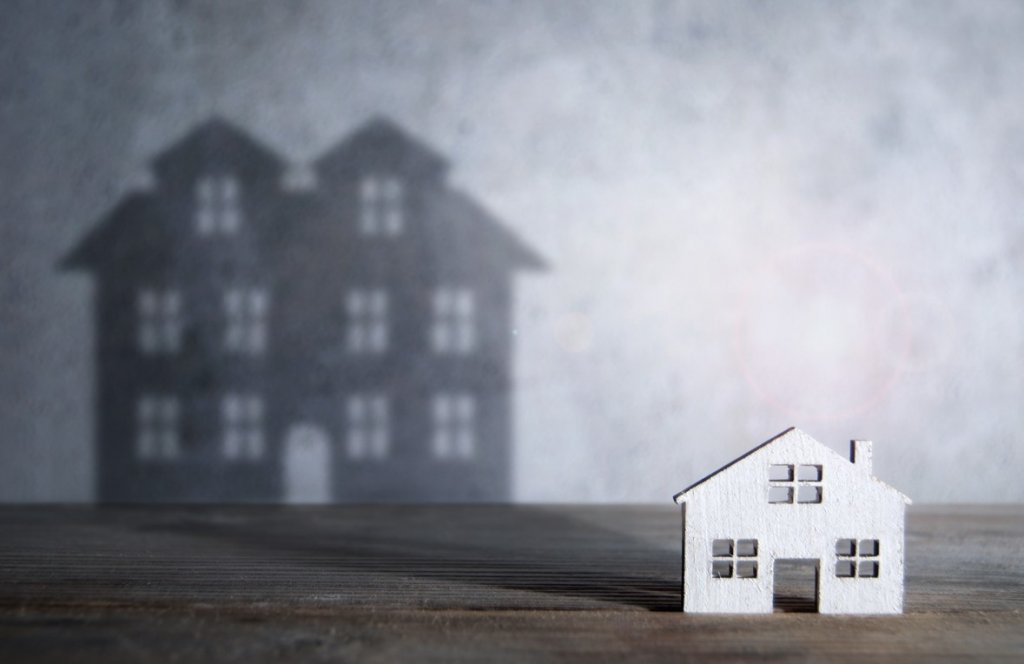
Why Reverse Decluttering?
Let’s start with the WHY behind reverse decluttering. Your personal purpose behind decluttering motivates you to find the right method for your situation and circumstances. It’s the WHY, or the purpose behind my decluttering motivation that led me to reverse decluttering.
During those 2 years and 3 moves, we went from living in a 3-bedroom home with a 2-car attached garage to a 1-bedroom apartment with a 1-car detached garage.
When we moved the first time, we had a lot of stuff to declutter, sell, give away, and donate. So I began considering different decluttering methods to use.
The Minimalists talk of having a “packing party.” However, if you’re a busy mom with little ones, a packing party may not be so practical. At the time that we moved out of our 3-bedroom home, my husband and I were both starting new jobs and our daughter was 3 years old.
We were packing up anyway to move, so a packing party didn’t seem to fit the situation. It’s also not very fun to do with a young child. We needed to unload most of our possessions and sell lots of furniture FAST!
The Marie Kondo version of decluttering has helped many people. Those who have used this method are flabbergasted at the sheer amount of stuff they own simply by putting everything from one category in the middle of their living room.
However, since we were moving and needed to declutter and unload our possessions quickly, this wasn’t an approach that would work as fast as I needed. Also, putting all the items from one category to the center of our home wouldn’t be as efficient with a sweet little 3-year-old around “helping.”

What is Reverse Decluttering?
One day during my lunch break at my new job, it dawned on me that I should work backwards by thinking of all the items off the top of my head that are truly the most important.
I thought, “If there was a fire at my house right now while I’m at work and everything burned, what are the things I can think of off the top of my head that I would miss, whether replaceable or irreplaceable?”
Now, you may be thinking “Sure, sure, it’s like the question of what I would bring with me on a deserted island?”
But I do think this exercise has some merit to it. Especially if you’ve tried decluttering methods and are still having trouble simplifying.
This is because reverse decluttering will help you focus on what’s important to KEEP, not what you “should” or “have to” get rid of.
Of course, we can’t subsist on NOTHING – but I had the inkling we owned a bit more than we needed to. With the impending move, it was important for us to be able to put our stuff away easily.
Reverse decluttering would help me focus on the ESSENTIALS to efficiently trim the EXCESS.

How Reverse Decluttering Will Help You Downsize
1| It will help you to be more objective.
When we consider what we would TRULY miss if we lost everything in a fire, it gives us a new perspective to realize that most of what we own is just stuff.
For example, we need to clothe ourselves. However, living in a first-world country with abundant consumerism, it’s easy to get clothes if the need arises.
Maybe we love our home decor, but at the end of the day if it were destroyed in a fire, we can hop over to Home Goods and replace them.
Thus, many things we own are simple to replace. I’m not saying that we should view everything as disposable. It’s worthwhile to own things we enjoy. But when it comes to simplifying, being properly objective helps.
This objectivity helped me to part with home decor, furniture, and hobby accessories that I knew wouldn’t fit in a smaller place. I sold most of these items on second-hand Facebook groups and apps like Offer Up.
2| It will help you declutter sentimental items.
Reverse decluttering helped me to identify the irreplaceable sentimental items that were the most valuable to me. I was able to conquer these 5 roadblocks that come up when decluttering sentimental items.
I asked myself what I would miss if my home burned down while I was at work. One of the first things that came to my mind was old childhood pictures that I hadn’t digitized yet.
I decided to get those pictures digitized quickly so that I wouldn’t lose them.
This would simplify my life by helping me shed a storage tote full of childhood albums and photos.
Other sentimental items that I’d been storing in huge storage totes didn’t seem as pertinent anymore. A few of them I took pictures of then donated, recycled, or threw them away.
Reverse decluttering can help you realize which sentimental items are truly the most treasured.
3| It will help you pare down everyday items.
Decluttering “useful” stuff can be challenging. These items don’t spark joy, but they may serve a practical purpose. The challenge lies in if you should keep them just in case!
These may be rarely used kitchen items like a juicer, waffle maker, serving platters, or an extra set of dishes. They could be gardening tools, clothes that no longer fit or aren’t worn much, too many shoes or purses, or even a plethora of toys.
Since our living space became smaller with each move, I wanted our home to function in a streamlined way. This meant culling the just in case items.
So I downsized our dishes to only what our family would need. Surprisingly, it made loading and unloading the dishwasher much less of a chore since the dishwasher is rarely stuffed to the brim!
I decluttered unused kitchen appliances. We created capsule wardrobes for each family member. I set a limit on the number of purses and shoes I realistically needed to own. Lastly, I became fairly adept at organizing small closets on a tight budget.

4| It can help you get clear on your goals and hobbies.
Through our 3 moves my husband and I ended up decluttering his guitar and my sewing machine which surprised me.
He can play the guitar and enjoys it, but he doesn’t pick it up as often as he used to. He ended up giving the guitar to a friend that didn’t own a guitar but wanted to learn to play.
I know how to sew and enjoy it, but hadn’t done it since becoming a mom and didn’t see myself getting back to it soon. Not to mention that I didn’t want to spend money on purchasing fabric. I didn’t want to spend my free time taking on new sewing projects.
Do you have different goals than you did in years prior? Have your hobbies changed over the years? Perhaps it’s time to shed those things and pass them on to someone who could use them.
Could Reverse Decluttering Work for You?
If you’re on a journey to simplify your life, the goal is to alleviate your home of excess clutter. That way you have room to truly live with intention, in whatever season you’re in.
Some seasons in life may force you to pare down your belongings, which can leave you overwhelmed wondering where to begin.
Conversely, maybe a new season has brought more clutter into your life leaving you wondering how to appropriately manage it.
Maybe a major change, whether positive or negative, has produced in you a desire to reset and simplify your life.
Regardless of the reason or the season, reverse decluttering can help you figure out what the essentials are in order to shed the excess.

Andrea is a firm believer that every mom can have a streamlined, organized home regardless of their budget. Through her blog, Simplifying Mom Life, she helps moms find realistic organization ideas that won’t break the bank. Join her on a quest to own less and create margin for what matters most!
Want to keep up to date with The Simplicity Habit? Fill out the form below to get weekly decluttering tips sent to your inbox. You’ll also get the Declutter Plan of Attack to help you create your unique decluttering plan.




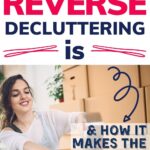
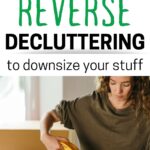
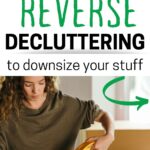
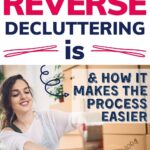
Thank you for sharing this. 🙂 I think this is probably a more practical way to declutter for many people. As someone who has had to move and downsize multiple times throughout life, this one really spoke to me. There was one time when I was 13 that we moved halfway across the country, traveling by train. So, we could only take what essentials we could put in a couple of boxes and our carry-on bags. Talk about downsizing! We went from a 3-bedroom townhouse to a furnished 1-bedroom apartment. We didn’t stay there long, but still, I’m familiar with the idea of realizing how little of your possessions you truly need.
I shared this blog with my sister-in-law recently. If she hasn’t read this post yet, I’ll recommend it to her. I think she’d really like it.
I’m glad you enjoyed it and thanks for sharing :).
I would caution folks when getting rid of hobby items that might be costly to replace as you might return to those activities when you retire, or during a pandemic, like I did.
Yes, that is going to vary a lot from person to person. If it’s still a hobby you enjoy, yes you may want to hang onto the things. If that season has passed in your life and you don’t plan to return to the activity, it’s fine to let it go.
I love to move because of this reason. I’ve had 15 different houses. I tell my kids ,live like we”re having open houses. Everyone thinks its hard work , but I believe lazy people keep perfect houses because they don’t want the work. My garage is empty and half of my kitchen cupboards too. All of my tables and counters are empty, quicker to dust or wipe down. We each have 2 sets of sheets and 2 towels. If I buy something , something leaves. Over the years , Ive gotten rid of books which I used to collect, cds, albums, videos. Even makeup, I noticed that all I consistently wear is eyeliner and mascara so thats all I have. I was teased by my sisters because each of my kids (4 of them) only had 7 outfits. What more did they need ? My kids only complaint was we never had a toaster. They learned pretty quickly how to use the oven. Now they all shun Gluten !
The “If there was a fire” thing is really helpful to me. I started using the Kondo method but bogged down on the first category — clothing — because I was losing weight and needed the larger clothes while I worked my way to the smaller clothes. (I’m almost finished and will keep it off because I’ve changed my whole approach to food because of a health issue.) I’ve been downsizing for a move, but your approach, I believe, is going to make a huge difference! One other thing that has helped is looking at something I might use/fix/alter “when I get to it” is telling myself “You’ve had this for _____ years and haven’t touched it, have done just fine without it, and you won’t even miss it.” If that is true about an item, out it goes! Thank you for giving me another very useful tool!
Yes, Lynn! So much of decluttering is about perspective and trying to be realistic. I’m glad this was helpful for you 🙂
This is a good read. In moving several times in my life, I too have found the method of looking at things in a used perspective i.e. if I haven’t used it in over a year, I don’t really need it. When it comes to the sentimental objects, and the crafts, I do have a harder time, but as technology, access and availability of things improves, so does the task of weeding out all types of things (like getting rid of actual photos etc.). It will never be easy to part with ‘treasures’, but as the amount of ‘stuff’ decreases, so does the difficulty in choosing what to let go.
I’m glad you found it helpful, Judi!
I really hope this helps me! I have too much of everything and feel overwhelmed. I feel attached to most of it! But am desperately trying to declutter and have a tidy house! I wish we were moving! Lol!
Even if you’re not moving, you can pretend you are! I hope these tips help 🙂
I know the feeling we haven’t moved since 1986 and my girls are grown and married, both our parents have passed so add in their things that mean a lot and I’m drowned in a house that holds to much . Sometimes I want to just loose everything or really just move and downsize.
Wow, great post. I wanted to ask, how did you go about digitizing your childhood photos, and how did you dispose of them once you had that done?
Hi Linda. I wrote a post about decluttering photos that you may find helpful here: https://www.thesimplicityhabit.com/how-to-declutter-photos-in-your-home/
I used to work in the senior living industry. When a senior had a hard time with the idea of letting items go, I would give them small post-it notes to stick to items they used daily and weekly. Then I had them stick it to items that had the most sentimental value. I would remind them they really only need x amount of kitchen towels, they rarely used all the shelves in the linen closet or the top cupboards in the kitchen and so on… this really helped and sounds a bit similar to what you have found works! We are wanting to move to a larger home from our small home (which we have outgrown) but getting rid of so many items seems overwhelming. We have too many items that we really don’t need or use. I think this method will work very well!
Beware of throwing away old photographs etc. there will be nothing to pass down to future generations. Digitalising things seems s good idea but not if it means the originals will be thrown away. The historian in me thinks about all the photos, medals etc that have been lost in my family throughout the years. Probably best to pass the stuff onto someone in the family.
I don’t think the author is recommending throwing away all old photos. I think she’s thinking more of the ones that we put into photo albums decades ago and never open. Do I really need to keep every physical photo I took in high school with all of my acquaintances that I haven’t seen in years, or can I instead scan them all and physically keep the most special ones?
When my grandparents died, we were overwhelmed by all of the vacation photos they took and all of the photos of acquaintances that weren’t labelled and none of us knew. I made a photo album of my 50 favorite photos of them and family members, scanned hundreds of others, and threw away many more. And that’s just me – plenty of other photos went to other family members and close friends.
This is a great concept and I’ve been thinking that way.
We moved from our home of 25 years to a mountain community and had to evacuate from the Creek Fire. After 3 weeks of living with only what we needed it was easy when a year later we moved from California to Florida. Downsizing has been wonderful.and having an empty garage and half full (if that) drawers & closets makes like easy & enjoyable.
Hi,I appreciate your ideas .I too need to declutter my home .Your article helped me and motivated me to start the task 🙂 Thanks a lot dear !!Stay blessed 🙌
Thank you!! I used this on my kids toys. Started at their favorites, used everyday, one I want to keep and then started getting rid of.
Same with household stuff!!
Love this way!
Yes! I’m pleased to read this article!
When decluttering, I have a list of questions I refer to if I am stuck making a decision (or desire to pare down further) and the most important one is, “Would I even miss this item if it was destroyed in a natural disaster?”
I have downsized to the bare minimum and moved intercontinentally three times. My fifty year old sewing machine has always made the move! I think getting rid of a sewing machine is a stupid idea. I no longer sew all my clothes but I am forever mending rips and split seams, hemming jeans, taking things in, etc. Last night I used the sewing machine to quickly stitch together the elastic for our new outdoor Christmas tree that my husband was assembling.
I just decluttered this winter. It felt good! Actually, I go through my stuff once a year, every winter. Somehow I always seem to find stuff to get rid of. Could it be because I collect more stuff throughout the year???? LOL.
I was Leary about decluttering at first. I keep a very neat home but had more stuff than I needed, always a fan of cozy country decor. now I just want open clean spaces. at first it felt like I was living in rental house but I’m getting to like the less is more look. I agree with not parting with craft items. been there done that and regretted it